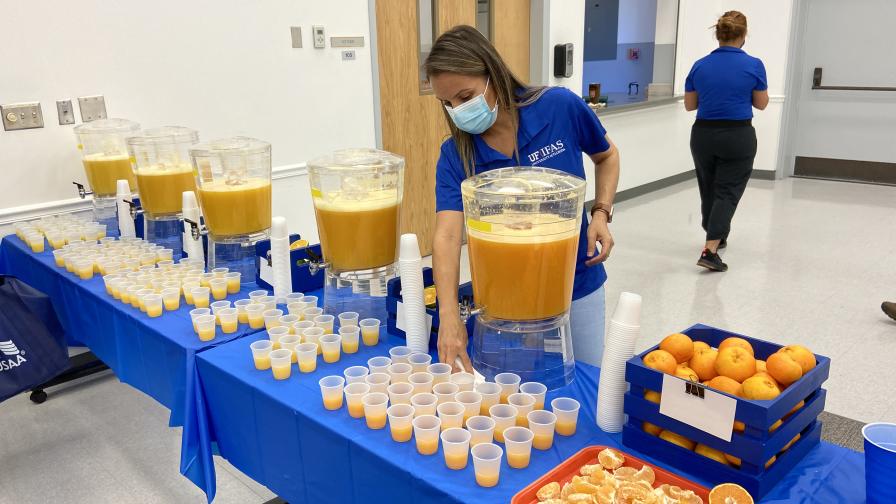New Orange-Like Citrus Hybrids to the Rescue

The Citrus Research and Education Center Plant Improvement Team at UF/IFAS compares orange-like hybrids with the current standards.
Photo by Peter Chaires
A tremendous effort is underway to develop select, trial, and release early and mid-season orange-like hybrids for possible use in the orange juice stream. Investments in breeding have established a large pipeline of material, much of which is beginning to bear. Each year, the process gains greater focus, as new breeding parents, each with a demonstrated propensity to pass on useful traits, are pressed into service.
For Florida, the next big step is the identification of potential orange-like contenders. This is no small undertaking. As efforts are underway to address regulatory hurdles, plant improvement teams are scouring their collections. The first few variety displays of the year highlighted some of the possibilities.
Below is a partial list of the early-mid candidates. The early and mid-season window is the highest priority, but we will ultimately see a range of maturities. To protect intellectual property, the code names have been omitted for the unreleased selections. The focus is processing, but some will have utility in the fresh channel.
UF CREC Plant Improvement Team
Dr. Fred Gmitter and Dr. Jude Grosser have a long history of breeding oranges and orange-like varieties.
Selection 1: Orange-like hybrid matures October/November; reaches 11 Brix and 40 juice color score early-mid October. Medium-sized fruit. High juice content. Juice flavor is mild and sweet. Some seeds. Fruit slightly softer than standard orange but should be amenable to trucking if not picked too late. One of the major orange juice companies likes the juice flavor profile. External fruit color appears to respond well to ethylene for fresh market appeal. Budwood in cleanup. Only one tree, so HLB tolerance largely unknown. Tree health improved considerably after Controlled Release Fertilizer (CRF) treatment.
Selection 2: Orange-like hybrid matures October/November; reaches 12 to 12.5 Brix and 39 juice color score in early-mid October. Small-medium orange-like seedless fruit, very good external color on the tree, and very rich-flavored juice. Should be cold hardy. Again, only one tree, so HLB tolerance is not completely known. Tree showed some dieback, but now showing strong recovery following CRF treatments. Budwood in cleanup.
Selection 3: Orange-like hybrid matures in December. Seedless, medium-sized, and morphologically the most orange-like fruit of this group. Juice reaches 12 Brix in mid-November with 36 juice color score. Original tree showing better health than standard oranges, and also showing a high yield with CRF treatment (nearly all fruit non-symptomatic). Post-harvest testing underway.
Selection 4: Orange-like hybrid can first be harvested mid-late November into late January. It is seedless and produces fruit with a high percentage of flavorful, well-colored juice. Orange peel in Nov-ember, but peel color develops into a deep red-orange hue over time. Unique/distinctive shape. The original tree was planted before HLB arrived. Since then it has held up quite well. Clean budwood. In trials.
USDA-ARS
Selection 1: ‘SunDragon’. ARS’ best characterized HLB-tolerant sweet-orange-like hybrid. Anne Plotto’s work shows tasters consider its juice to be one of most OJ-like hybrids tested to date. She notes that it maintains quality from late November to late January or even early February.
Titratable acidity (TA) range 0.60 to 0.87, Soluble Solids Content (SSC) range 10.3 to 14.0, SSC/TA range 13.6 to 22. Several processors have tested and report promising results. Trials in multiple sites. Initial analyses showed around 11 Brix , 11 ratio and 33 color score on Nov. 1. Quality remains good through Jan. with 12-13 Brix and 12 ratio and 35 color. Taste and internal texture are very orange-like and very good according to most tasters.
Very few seeds. No detectable trifoliate taste or smell. Fruit are often nosy and range greatly in size. Peel adherent and fruit seem sturdy enough for standard trailer loads, but needs to be tested. Yield is modest at 1-2 boxes per tree. Tree architecture is leggy and may be well suited to higher density plantings. Pedigree may complicate regulatory approval for OJ. Budwood trees are clean at DPI and the cultivar is publicly released and selected for CRDF replicated trials.
Selection 2: Tolerant Mandarin x ‘SunDragon’: Observations from a single tree which is the original own-rooted hybrid seedling. This is a very nice orange-like fruit that has better color than SunDragon. The parents are the two most HLB-tolerant USDA advanced selections and the original tree seems tolerant to HLB. Productivity is unknown. In initial tests was 12 Brix mid-Sept and 13-15 mid-Oct. through mid-Dec. Trifoliate off-taste isn’t noticed. ARS analysis found the juice agreeable and OJ like. Poncirus in pedigree may complicate regulatory approval for OJ. Expected to be clean from DPI in the next two months. Selected for CRDF replicated trials.
Selection 3: Observations from a single tree which is the original own-rooted hybrid. Selection made in 2019. Best orange-like hybrid expressing Kishu seedlessness. External and internal appearance very orange-like, with firm flesh and peel. Tree has a compact growth habit.
UF-Gainesville Breeding Program
Dr. José Chaparro recently shifted some of his focus to orange-like material, using parents already in his collection.
Selection 1: ‘Sherman’. Early Ripening (October) and cold hardy. The tree is actually deciduous. Fruit is seedy. Flavor is mild, but with solid brix in the 12 range. Ratios range from 14.5-14.8. Not graft compatible with US 942. Its primary drawbacks are thorniness and canker susceptibility. Released and cleaned. Displayed in October.
Selection 2: November maturing hybrid. Seedy. Mild flavor. Brix in the 14 range. Weaknesses are weak flesh color and thorns.
Interested parties can see the latest orange-like creations at the scheduled displays.
Author note: Appreciation to Dr. Fred Gmitter, Dr. Jude Grosser, Dr. Ed Stover, and Dr. José Chaparro for contributions to this article.










